Publications
Demographics, Symptoms, Psychotropic Use, and Caregiver Distress in Patients with Early vs Late Onset Dementia

David R Lee, MD, Tamineh Romero, MS, Katherine Sy Serrano, MPH, Michelle Panlilio, DNP, Abel Rojas-Parra MD, Lauren Matsuno, MD, Mario Mendez, MD, Christine Willinger, MD, David B Reuben, MD
Understanding experiences and challenges faced by persons living with Early-Onset Dementia (EOD) compared to individuals diagnosed with Late-Onset Dementia (LOD) is important for the development of targeted interventions.
Dementia Prevention and Treatment: A Narrative Review

David B. Reuben, MD, Sarah Kremen, MD, Donovan T Maust, MD
Importance Dementia affects 10% of those 65 years or older and 35% of those 90 years or older, often with profound cognitive, behavioral, and functional consequences. As the baby boomers and subsequent generations age, effective preventive and treatment strategies will assume increasing importance.
The Other Dementia Breakthrough- Comprehensive Dementia Care

David B. Reuben, Gary Epstein-Lubow, Nora Super, MPA
These are momentous times for Alzheimer disease (AD) and Alzheimer disease and related dementias (ADRDs). For the first time, the US Food and Drug Administration has approved disease-modifying drugs that bring some hope for long-term clinical benefit for persons affected by mild cognitive impairment or early to mild dementia. Unfortunately, most persons living with AD and those with other causes of dementia will not be eligible to receive these new drugs. Nevertheless, they may benefit substantially from comprehensive dementia care that includes caregiver support, continuous monitoring and assessment, ongoing care plans, psychosocial interventions, self-management, medication management, treatment of related conditions, coordination of care, and advance care planning.
Dementia care navigation: Building toward a common definition, key principles, and outcomes
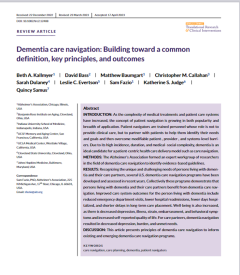
Beth A. Kallmyer; David Bass; Matthew Baumgart; Christopher M. Callahan; Sarah Dulaney; Leslie C. Evertson; Sam Fazio; Katherine S. Judge; and Quincy Samus
As the complexity of medical treatments and patient care systems have increased, the concept of patient navigation is growing in both popularity and breadth of application. Patient navigators are trained personnel whose role is not to provide clinical care, but to partner with patients to help them identify their needs and goals and then overcome modifiable patient-, provider-, and systems-level barriers. Due to its high incidence, duration, and medical–social complexity, dementia is an ideal candidate for a patient-centric health care delivery model such as care navigation.
Project Reports: The University of California, Los Angeles Alzheimer's and Dementia Care Program (UCLA ADC Program)
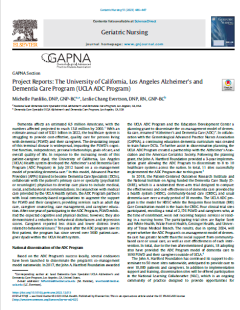
Michelle Panlilio DNP, GNP-BC; Leslie Evertson, DNP, RN, GNP-BC
Dementia affects an estimated 6.5 million Americans, with the numbers affected projected to reach 13.8 million by 2060. With an estimate annual cost of $321 billion in 2022, the healthcare system is struggling to provide cost-effective, quality care for persons living with dementia (PLWD) and their caregivers. The devastating impact of this terminal disease is widespread, impacting the PLWD's cognitive function, independence, personal relationships, goals of care, and overall quality of life. In response to the increasing needs of this patient-caregiver dyad, the University of California, Los Angeles (UCLA) Health system developed the Alzheimer's and Dementia Care Program (ADC Program) in July 2012 based on a co-management model of providing dementia care.
Dissemination of a Successful Dementia Care Program: Lessons to Facilitate Spread of Innovations
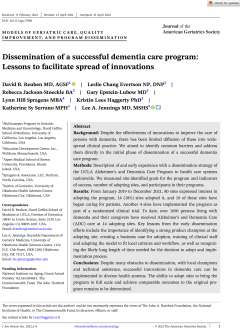
David B. Reuben MD, AGSF; Leslie Chang Evertson NP, DNP; Rebecca Jackson-Stoeckle BA; Gary Epstein-Lubow MD; Lynn Hill Spragens MBA; Kristin Lees Haggerty PhD; Katherine Sy Serrano, MPH; Lee A. Jennings MS, MSHS
Despite the effectiveness of innovations to improve the care of persons with dementia, there has been limited diffusion of these into widespread clinical practice. We aimed to identify common barriers and address them directly in the initial phase of dissemination of a successful dementia care program.
Dissemination of a Successful Dementia Care Program: Lessons from Early Adopters
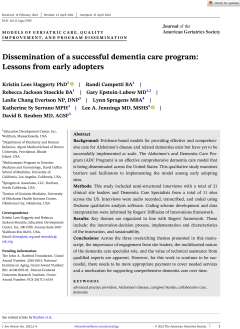
Kristin Lees Haggerty PhD; Randi Campetti BA; Rebecca Jackson-Stoeckle BA; Gary Epstein-Lubow MD; Leslie Chang Evertson NP, DNP; Lynn Hill Spragens MBA; Katherine Sy Serrano, MPH; Lee A. Jennings MS, MSHS; David B. Reuben MD, AGSF
Evidence-based models for providing effective and comprehensive care for Alzheimer's disease and related dementias exist but have yet to be successfully implemented at scale. The Alzheimer's and Dementia Care Program (ADC Program) is an effective comprehensive dementia care model that is being disseminated across the United States. This qualitative study examines barriers and facilitators to implementing the model among early adopting sites.
Caregiver Outcomes of a Dementia Care Program
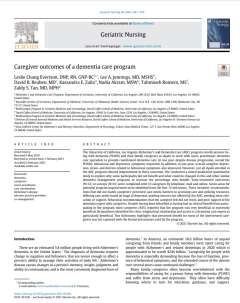
Leslie Chang Evertson, DNP, RN, GNP-BC, Lee A. Jennings, MD, MSHS, David B. Reuben, MD, Kassandra E. Zaila, Nadia Akram, MSW, Tahmineh Romero, MS, Zaldy S. Tan, MD, MPH
The University of California, Los Angeles Alzheimer's and Dementia Care (ADC) program enrolls persons living with dementia (PLWD) and their family caregivers as dyads to work with nurse practitioner dementia care specialists to provide coordinated dementia care. At one year, despite disease progression, overall the PLWDs' behavioral and depressive symptoms improved. In addition, at one-year, overall caregiver depression, strain, and distress related to behavioral symptoms also improved. However, not all dyads enrolled in the ADC program showed improvement in these outcomes. We conducted a mixed qualitative-quantitative study to explore why some participants did not benefit and what could be changed in this and other similar dementia management programs to increase the percentage who benefit. Semi-structured interviews (N=12) or surveys (N=41) were completed with 53 caregivers by telephone, mail and online. Seven areas for potential program improvement were identified from the first 12 interviews. These included: recommendations that did not match caregivers' perceived care needs, barriers to accessing care and utilizing resources, differing care needs based on stage of dementia, needing services not offered by the ADC, needing more education or support, behavioral recommendations that the caregiver felt did not work, and poor rapport of the dementia expert with caregivers. Despite having been identified as having had no clinical benefit from participating in the program, most caregivers (85%) reported that the program was very beneficial or extremely beneficial. Respondents identified the close, longitudinal relationship and access to a dementia care expert as particularly beneficial. This dichotomy highlights that perceived benefit for most of the interviewed caregivers was not captured with the formal instruments used by the program.
The Effects of Dementia Care Co-Management on Acute Care, Hospice, and Long-Term Care Utilization
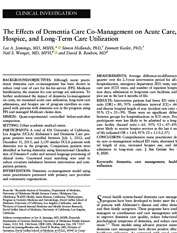
Lee A. Jennings, MD, MSHS,* Simon Hollands, PhD, Emmett Keeler, PhD, Neil S. Wenger, MD, MPH, and David B. Reuben, MD
Although nurse practitioner dementia care co-management has been shown to reduce total cost of care for fee-for-service (FFS) Medicare beneficiaries, the reasons for cost savings are unknown. To further understand the impact of dementia co-management on costs, we examined acute care utilization, long-term care admissions, and hospice use of program enrollees as compared with persons with dementia not in the program using FFS and managed Medicare claims data. Quasi-experimental controlled before-and-after comparison. Urban academic medical center. A total of 856 University of California, Los Angeles (UCLA) Alzheimer's and Dementia Care program patients were enrolled between July 1, 2012, and December 31, 2015, and 3,139 similar UCLA patients with dementia not in the program. Comparison patients were identified as having dementia using International Classification of Diseases-9 codes and natural language processing of clinical notes. Coarsened exact matching was used to reduce covariate imbalance between intervention and comparison patients. Dementia co-management model using nurse practitioners partnered with primary care providers and community organizations. Average difference-in-differences per quarter over the 2.5-year intervention period for all-cause hospitalization, emergency department (ED) visits, intensive care unit (ICU) stays, and number of inpatient hospitalization days; admissions to long-term care facilities; and hospice use in the last 6 months of life. Intervention patients had fewer ED visits (odds ratio [OR] = .80; 95% confidence interval [CI] = .66–.97) and shorter hospital length of stay (incident rate ratio = .74; 95% CI = .55–.99). There were no significant differences between groups for hospitalizations or ICU stays. Program participants were less likely to be admitted to a long-term care facility (hazard ratio = .65; 95% CI = .47–.89) and more likely to receive hospice services in the last 6 months of life (adjusted OR = 1.64; 95% CI = 1.13–2.37). Comprehensive nurse practitioner dementia care co-management reduced ED visits, shortened hospital length of stay, increased hospice use, and delayed admission to long-term care. J Am Geriatr Soc 00:1- 8, 2020.
An Automated Approach to Identifying Patients with Dementia Using Electronic Medical Records
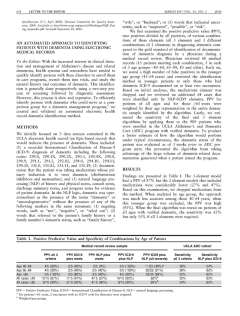
Reuben DB, Hackbarth AS, Wenger NS, Tan ZS, and Jennings LA
With the increased interest in clinical detection and management of Alzheimer’s disease and related dementias, health systems and researchers have needed to quickly identify persons with these disorders to enroll them in care programs, recruit them into trials, and study the natural history and outcomes of dementia. This identification is generally done prospectively using a two-step process of screening followed by diagnostic assessment. However, this process is slow and expensive. To efficiently identify persons with dementia who could serve as a comparison group for a dementia management program, we created and validated an automated electronic health record dementia identification method.
Coordinated Care Management For Dementia in a Large Academic Health System
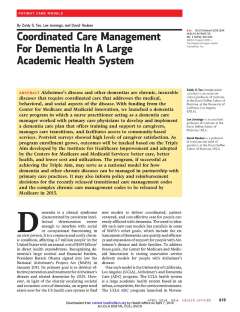
Tan ZS, Jennings LA, and Reuben DB
Alzheimer's disease and other dementias are chronic, incurable diseases that require coordinated care that addresses the medical, behavioral, and social aspects of the disease. With funding from the Center for Medicare and Medicaid Innovation, we launched a dementia care program in which a nurse practitioner acting as a dementia care manager worked with primary care physicians to develop and implement a dementia care plan that offers training and support to caregivers, manages care transitions, and facilitates access to community-based services. Postvisit surveys showed high levels of caregiver satisfaction. As program enrollment grows, outcomes will be tracked based on the Triple Aim developed by the Institute for Healthcare Improvement and adopted by the Centers for Medicare and Medicaid Services: better care, better health, and lower cost and utilization. The program, if successful at achieving the Triple Aim, may serve as a national model for how dementia and other chronic diseases can be managed in partnership with primary care practices. It may also inform policy and reimbursement decisions for the recently released transitional care management codes and the complex chronic care management codes to be released by Medicare in 2015.
The Effect of a Comprehensive Dementia Care Management Program on End-of-Life Care
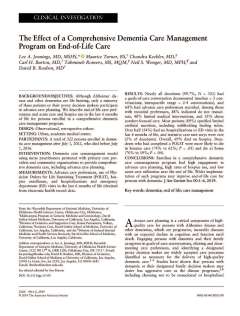
Jennings LA, Turner M, Keebler C, Burton CH, Romero T, Wenger NS, and Reuben DB
Advance care planning is a critical component of high-quality care for persons with Alzheimer disease and other dementias, which are progressive, incurable diseases with an expected decline in cognition and function until death. Engaging persons with dementia and their family caregivers in goals-of-care conversations, eliciting and documenting care preferences, and identifying a designated proxy decision maker are widely accepted care processes identified as necessary for the delivery of high-quality dementia care. Studies have shown that persons with dementia or their designated family decision makers may desire less aggressive care as the disease progresses, including choosing not to be resuscitated or hospitalized and enrolling in hospice services. However, persons with dementia may receive unwanted care at the end of life because aggressive interventions, including cardiopulmonary resuscitation (CPR) and intubation, are the default in US acute care settings if care preferences are unknown. Moreover, lack of an advance directive, multiple care transitions from hospital to nursing home, and placement of feeding tubes have been associated with poor outcomes among persons with dementia, including decubitus ulcers, late enrollment in hospice, receipt of care in the intensive care unit (ICU) in the last month of life, and in-hospital death.
Health Care Utilization and Cost Outcomes of a Comprehensive Dementia Care Program for Medicare Beneficiaries
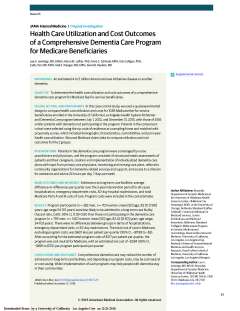
Jennings LA, Laffan AM, Schlissel AC, Colligan E, Tan ZS, Wenger NS, and Reuben DB
In the United States, Alzheimer disease and related dementias affect an estimated 4 to 5 million persons. Dementia is a chronic disease that requires comprehensive medical and social services to provide high-quality care and prevent complications and hospitalizations. This care is expensive, with annual estimated costs of $157 billion to $215 billion in 2010. The total societal costs of dementia are expected to increase nearly 80% by 2040.
Patient and Caregiver Benefit From a Comprehensive Dementia Care Program: 1-Year Results From the UCLA Alzheimer’s and Dementia Care Program
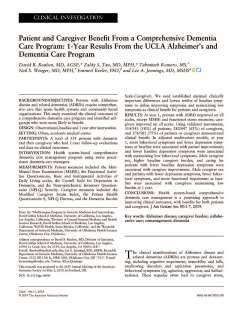
Reuben DB, Tan ZS, Romero T, Wenger NS, Keeler E, and Jennings LA
The clinical manifestations of Alzheimer disease and related dementias (ADRDs) are protean and devastating, including cognitive impairment, immobility and falls, swallowing disorders and aspiration pneumonia, and behavioral symptoms (eg, agitation, aggression, and hallucinations). These sequelae often lead to caregiver stress, burnout, and medical illnesses. Thus, ADRDs can be considered the archetype for a disorder with complex needs that span both the patient and caregiver, include medical and social domains, and require health system and community-based interventions.
Patient and Caregiver Goals for Dementia Care
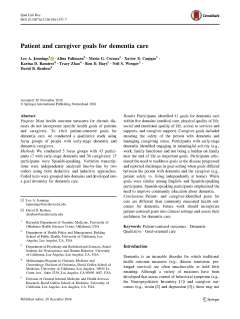
Jennings LA, Palimaru A, Corona MG, Cagigas XE, Ramirez KD, Zhao T, Hays RD, Wenger NS, and Reuben DB
Dementia is an incurable disorder for which traditional health outcome measures (e.g., disease remission, prolonged survival) are often unachievable or hold little meaning. Although a variety of measures have been developed that assess control of behavioral symptoms (e.g. the Neuropsychiatric Inventory) and caregiver outcomes (e.g., strain and depression), these may not capture everything that may be important to patients and their caregivers as they face the medical, behavioral, and social consequences of dementia.
Personalized Goal Attainment in Dementia Care: Measuring What Persons with Dementia and Their Caregivers Want
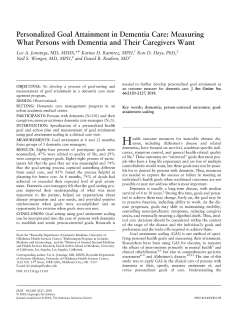
Jennings LA, Ramirez KD, Hays RD, Wenger NS, and Reuben DB
Health outcome measures for incurable chronic diseases, including Alzheimer’s disease and related dementias, have focused on survival, condition-specific indicators, symptom control, and general health-related quality of life. These outcomes are “universal” goals that most people who have a long life expectancy and are free of multiple comorbidities would want, but these goals may not be possible for or desired by persons with dementia. Thus, measures are needed to capture the success or failure in meeting an individual’s health goals when traditional outcomes are not possible or may not address what is most important.
Quality of Care Provided by a Comprehensive Dementia Care Comanagement Program
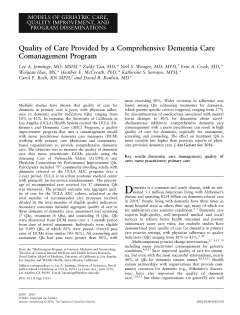
Jennings LA, Tan ZS, Wenger NS, Cook EA, Han W, McCreath HE, Serrano KS, Roth CP, and Reuben DB
Multiple studies have shown that quality of care for dementia in primary care is poor, with physician adherence to dementia quality indicators (QIs) ranging from 18% to 42%. In response, the University of California at Los Angeles (UCLA) Health System created the UCLA Alzheimer’s and Dementia Care (ADC) Program, a quality improvement program that uses a comanagement model with nurse practitioner dementia care managers (DCM) working with primary care physicians and community-based organizations to provide comprehensive dementia care. The objective was to measure the quality of dementia care that nurse practitioner DCMs provide using the Assessing Care of Vulnerable Elders (ACOVE-3) and Physician Consortium for Performance Improvement QIs. Participants included 797 community-dwelling adults with dementia referred to the UCLA ADC program over a 2-year period. UCLA is an urban academic medical center with primarily fee-for-service reimbursement. The percentage of recommended care received for 17 dementia QIs was measured. The primary outcome was aggregate quality of care for the UCLA ADC cohort, calculated as the total number of recommended care processes received divided by the total number of eligible quality indicators. Secondary outcomes included aggregate quality of care in three domains of dementia care: assessment and screening (7 QIs), treatment (6 QIs), and counseling (4 QIs). QIs were abstracted from DCM notes over a 3-month period from date of initial assessment. Individuals were eligible for 9,895 QIs, of which 92% were passed. Overall pass rates of DCMs were similar (90–96%). All counseling and assessment QIs had pass rates greater than 80%, with most exceeding 90%. Wider variation in adherence was found among QIs addressing treatments for dementia, which patient-specific criteria triggered, ranging from 27% for discontinuation of medications associated with mental status changes to 86% for discussion about acetylcholinesterase inhibitors. Comprehensive dementia care comanagement with a nurse practitioner can result in high quality of care for dementia, especially for assessment, screening, and counseling. The effect on treatment QIs is more variable but higher than previous reports of physician-provided dementia care.
The University of California at Los Angeles Alzheimer's and Dementia Care Program for Comprehensive, Coordinated, Patient-Centered Care: Preliminary Data
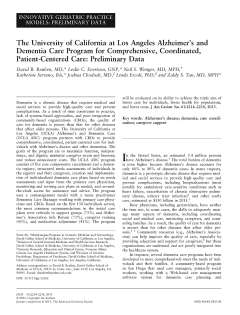
Reuben DB, Evertson LC, Wenger NS, Serrano K, Chodosh J, Ercoli L, and Tan ZS
Dementia is a chronic disease that requires medical and social services to provide high-quality care and prevent complications. As a result of time constraints in practice, lack of systems-based approaches, and poor integration of community-based organizations (CBOs), the quality of care for dementia is poorer than that for other diseases that affect older persons. The University of California at Los Angeles (UCLA) Alzheimer’s and Dementia Care (UCLA ADC) program partners with CBOs to provide comprehensive, coordinated, patient-centered care for individuals with Alzheimer’s disease and other dementias. The goals of the program are to maximize function, independence, and dignity; minimize caregiver strain and burnout; and reduce unnecessary costs. The UCLA ADC program consists of five core components: recruitment and a dementia registry, structured needs assessments of individuals in the registry and their caregivers, creation and implementation of individualized dementia care plans based on needs assessments and input from the primary care physicians, monitoring and revising care plans as needed, and around-the-clock access for assistance and advice. The program uses a comanagement model with a nurse practitioner Dementia Care Manager working with primary care physicians and CBOs. Based on the first 150 individuals served, the most common recommendations in the initial care plans were referrals to support groups (73%) and Alzheimer’s Association Safe Return (73%), caregiver training (45%), and medication adjustment (41%). The program will be evaluated on its ability to achieve the triple aim of better care for individuals, better health for populations, and lower costs.
Unmet Needs of Caregivers of Individuals Referred to a Dementia Care Program
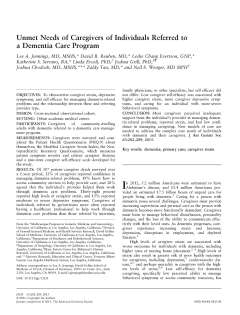
Jennings LA, Reuben DB, Evertson LC, Serrano KS, Ercoli L, Grill J, Chodosh J, Tan ZS, and Wenger NS
In 2012, 5.2 million Americans were estimated to have Alzheimer’s disease, and 15.4 million Americans provided an estimated 17.5 billion hours of unpaid care for people living with dementia. Caring for a person with dementia poses several challenges. Caregivers must provide increasing supervision and personal care as the person with dementia becomes more functionally dependent. Caregivers must learn to manage behavioral disturbances, personality changes, and the loss of the ability to communicate effectively with their loved ones. As dementia progresses, caregivers experience increasing strain and burnout, depression, disruptions in employment, and depleted finances.